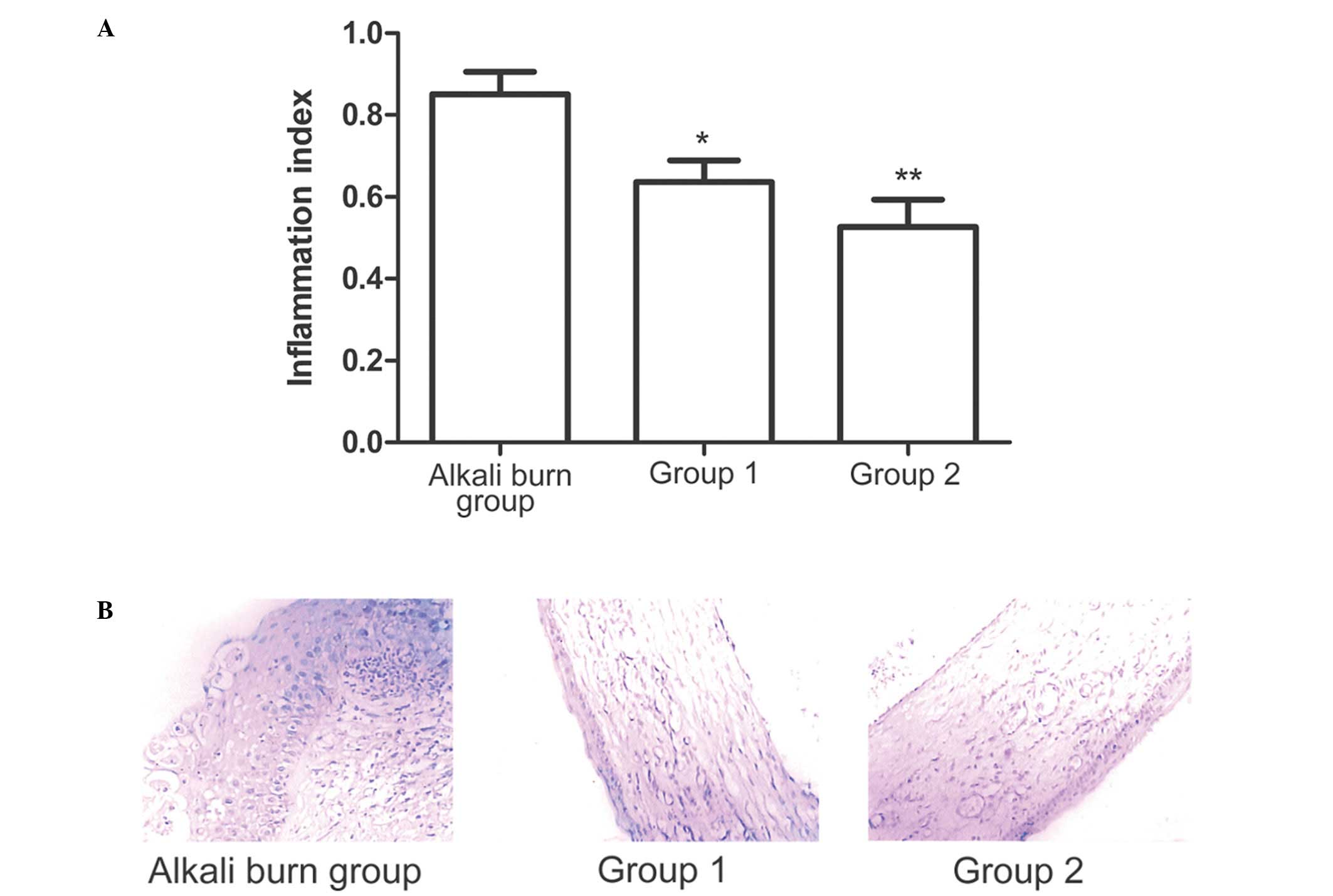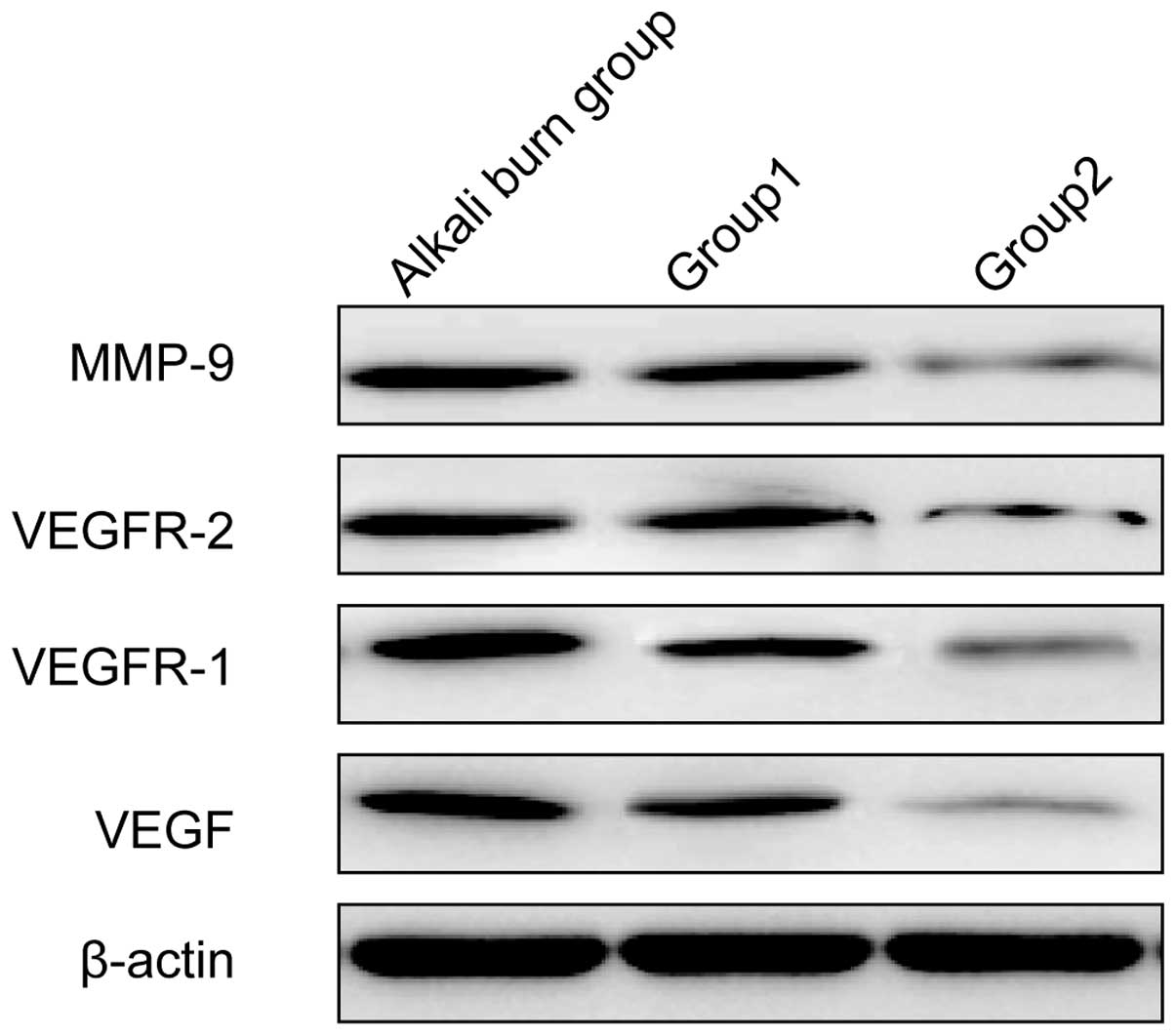|
1
|
Siemerink MJ, Augustin AJ and Schlingemann
RO: Mechanisms of ocular angiogenesis and its molecular mediators.
Dev Ophthalmol. 46:4–20. 2010. View Article : Google Scholar : PubMed/NCBI
|
|
2
|
Maddula S, Davis DK, Maddula S, Burrow MK
and Ambati BK: Horizons in therapy for corneal angiogenesis.
Ophthalmology. 118:591–599. 2011. View Article : Google Scholar : PubMed/NCBI
|
|
3
|
Chang JH, Garg NK, Lunde E, Han KY, Jain S
and Azar DT: Corneal neovascularization, An anti-VEGF therapy
review. Surv Ophthalmol. 57:415–429. 2012. View Article : Google Scholar : PubMed/NCBI
|
|
4
|
Chang JH, Gabison EE, Kato T and Azar DT:
Corneal neovascularization. Curr Opin Ophthalmol. 12:242–249. 2001.
View Article : Google Scholar : PubMed/NCBI
|
|
5
|
Hsu CC, Chang HM, Lin TC, Hung KH, Chien
KH, Chen SY, Chen SN and Chen YT: Corneal neovascularization and
contemporary antiangiogenic therapeutics. J Chin Med Assoc.
78:323–330. 2015. View Article : Google Scholar : PubMed/NCBI
|
|
6
|
Morabito A, De Maio E, Di Maio M, Normanno
N and Perrone F: Tyrosine kinase inhibitors of vascular endothelial
growth factor receptors in clinical trials: Current status and
future directions. Oncologist. 11:753–764. 2006. View Article : Google Scholar : PubMed/NCBI
|
|
7
|
Phillips K, Arffa R, Cintron C, Rose J,
Miller D, Kublin CL and Kenyon KR: Effects of prednisolone and
medroxyprogesterone on corneal wound healing, ulceration, and
neovascularization. Arch Ophthalmol. 101:640–643. 1983. View Article : Google Scholar : PubMed/NCBI
|
|
8
|
Dana R: Comparison of topical
interleukin-1 vs tumor necrosis factor-alpha blockade with
corticosteroid therapy on murine corneal inflammation
neovascularization, and transplant survival (an American
Ophthalmological Society thesis). Trans Am Ophthalmol Soc.
105:330–343. 2007.PubMed/NCBI
|
|
9
|
Lipman RM, Epstein RJ and Hendricks RL:
Suppression of corneal neovascularization with cyclosporine. Arch
Ophthalmol. 110:405–407. 1992. View Article : Google Scholar : PubMed/NCBI
|
|
10
|
Li C, Li L, Cheng R, Dai Z, Li C, Yao Y,
Zhou T, Yang Z, Gao G and Yang X: Acidic/neutral amino acid
residues substitution in NH2 terminal of plasminogen kringle 5
exerts enhanced effects on corneal neovascularization. Cornea.
32:680–688. 2013. View Article : Google Scholar : PubMed/NCBI
|
|
11
|
Jovanovic V and Nikolic L: The effect of
topical doxycycline on corneal neovascularization. Curr Eye Res.
39:142–148. 2014. View Article : Google Scholar : PubMed/NCBI
|
|
12
|
Mehrjardi HZ, Ghaffari R, Mahbod M and
Hashemi H: Triamcinolone acetonide as an adjunct to bevacizumab for
prevention of corneal neovascularization in a rat model. J
Ophthalmic Vis Res. 9:162–168. 2014.PubMed/NCBI
|
|
13
|
Schiele TM, Herbst J, Pӧllinger B, Rieber
J, Kӧnig A, Sohn HY, Krötz F, Leibig M, Belka C and Klauss V: Late
and very late catch-up after 90Sr/90Y
beta-irradiation for the treatment of coronary in-stent restenosis.
Acute Card Care. 13:9–13. 2011. View Article : Google Scholar : PubMed/NCBI
|
|
14
|
Shi CB, Yuan B, Lu JR, Xu JL, Yang WD,
Deng JL and Wang J: Continuous low-dose-rate radiation of
radionuclide phosphorus-32 for hemangiomas. Cancer Biother
Radiopharm. 27:198–203. 2012. View Article : Google Scholar : PubMed/NCBI
|
|
15
|
Huang CM, Lee KW and Huang CJ: Radiation
therapy for life-threatening huge laryngeal hemangioma involving
pharynx and parapharyngeal space. Head Neck. 35:E98–E101. 2013.
View Article : Google Scholar : PubMed/NCBI
|
|
16
|
Feng K, Yang J and Li B: An investigation
on morphology of experimental corneal neovascularization. Zhonghua
Yan Ke Za Zhi. 37:384–386. 2001.(In Chinese). PubMed/NCBI
|
|
17
|
British Photobiology Society; Association
for Research in Vision and Ophthalmology. Proceedings of a meeting
on visual sensitivity and adaptation. Sponsored by the British
Photobiology Society and the Association for Research in Vision and
Ophthalmology Inc. held at the University of Surrey Guildford,
19-23 September, 1978. Vision research. 19:351–440. 1979.
|
|
18
|
Lu P, Li L, Mukaida N and Zhang X:
Alkali-induced corneal neovascularization is independent of
CXCR2-mediated neutrophil infiltration. Cornea. 26:199–206. 2007.
View Article : Google Scholar : PubMed/NCBI
|
|
19
|
Zhou WJ, Liu GQ, Li LB, Zhang XG and Lu
PR: Inhibitory effect of CCR3 signal on alkali-induced corneal
neovascularization. Int J Ophthalmol. 5:251–257. 2012.PubMed/NCBI
|
|
20
|
Zhou Q, Yang L, Qu M, Wang Y, Chen P, Wang
Y and Shi W: Role of senescent fibroblasts on alkali-induced
corneal neovascularization. J Cell Physiol. 227:1148–1156. 2012.
View Article : Google Scholar : PubMed/NCBI
|
|
21
|
Needleman P, Turk J, Jakschik BA, Morrison
AR and Lefkowith JB: Arachidonic acid metabolism. Annu Rev Biochem.
55:69–102. 1986. View Article : Google Scholar : PubMed/NCBI
|
|
22
|
Nakayama M, Iejima D, Akahori M, Kamei J,
Goto A and Iwata T: Overexpression of HtrA1 and exposure to
mainstream cigarette smoke leads to choroidal neovascularization
and subretinal deposits in aged mice. Invest Ophthalmol Vis Sci.
55:6514–6523. 2014. View Article : Google Scholar : PubMed/NCBI
|
|
23
|
Peng LH, Shen W, Yong W, Lu L and Liu L:
Effects of AMD3100 subconjunctival injection on alkali burn induced
corneal neovascularization in mice. Int J Ophthalmol. 4:44–48.
2011.PubMed/NCBI
|
|
24
|
Bachmann B, Taylor RS and Cursiefen C: The
association between corneal neovascularization and visual acuity, A
systematic review. Acta Ophthalmol. 91:12–19. 2013. View Article : Google Scholar : PubMed/NCBI
|
|
25
|
Kruse FE, Joussen AM, Rohrschneider K,
Becker MD and Vӧlcker HE: Thalidomide inhibits corneal angiogenesis
induced by vascular endothelial growth factor. Graefes Arch Clin
Exp Ophthalmol. 236:461–466. 1998. View Article : Google Scholar : PubMed/NCBI
|
|
26
|
Gohto Y, Obana A, Kanai M, Nagata S,
Nakajima S and Miki T: Treatment parameters for selective occlusion
of experimental corneal neovascularization by photodynamic therapy
using a water soluble photosensitizer, ATX-S10(Na). Exp Eye Res.
72:13–22. 2001. View Article : Google Scholar : PubMed/NCBI
|
|
27
|
Haynes WL, Proia AD and Klintworth GK:
Effect of inhibitors of arachidonic acid metabolism on corneal
neovascularization in the rat. Invest Ophthalmol Vis Sci.
30:1588–1593. 1989.PubMed/NCBI
|
|
28
|
Daya SM and Ilari FA: Living related
conjunctival limbal allograft for the treatment of stem cell
deficiency. Ophthalmology. 108:126–134. 2001. View Article : Google Scholar : PubMed/NCBI
|
|
29
|
Faraj LA, Elalfy MS, Said DG and Dua HS:
Fine needle diathermy occlusion of corneal vessels. Br J
Ophthalmol. 98:1287–1290. 2014. View Article : Google Scholar : PubMed/NCBI
|
|
30
|
Williams KA, Irani YD and Klebe S: Novel
therapeutic approaches for corneal disease. Discov Med. 15:291–299.
2013.PubMed/NCBI
|
|
31
|
Giacomini C, Ferrari G, Bignami F and Rama
P: Alkali burn versus suture-induced corneal neovascularization in
C57BL/6 mice, An overview of two common animal models of corneal
neovascularization. Exp Eye Res. 121:1–4. 2014. View Article : Google Scholar : PubMed/NCBI
|
|
32
|
Navarro-Antolín J, Redondo-Horcajo M,
Zaragoza C, Alvarez-Barrientos A, Fernández AP, León-Gómez E,
Rodrigo J and Lamas S: Role of peroxynitrite in endothelial damage
mediated by Cyclosporine A. Free Radic Biol Med. 42:394–403. 2007.
View Article : Google Scholar : PubMed/NCBI
|
|
33
|
Li X, Li NC, Wang G and Na YQ: Effect and
safety of transrectal 137 CS gamma-rays in the treatment of benign
prostatic hyperplasia. Zhonghua Nan Ke Xue. 12:525–527. 2006.(In
Chinese). PubMed/NCBI
|
|
34
|
Onoda JM, Kantak SS and Diglio CA:
Radiation induced endothelial cell retraction in vitro, Correlation
with acute pulmonary edema. Pathol Oncol Res. 5:49–55. 1999.
View Article : Google Scholar : PubMed/NCBI
|
|
35
|
Martin G, Schlunck G, Hansen LL and
Agostini HT: Differential expression of angioregulatory factors in
normal and CNV-derived human retinal pigment epithelium. Graefes
Arch Clin Exp Ophthalmol. 242:321–326. 2004. View Article : Google Scholar : PubMed/NCBI
|
|
36
|
Carmeliet P and Jain RK: Angiogenesis in
cancer and other diseases. Nature. 407:249–257. 2000. View Article : Google Scholar : PubMed/NCBI
|
|
37
|
Philipp W, Speicher L and Humpel C:
Expression of vascular endothelial growth factor and its receptors
in inflamed and vascularized human corneas. Invest Ophthalmol Vis
Sci. 41:2514–2522. 2000.PubMed/NCBI
|
|
38
|
Lee CM, Jung WK, Na G, Lee DS, Park SG,
Seo SK, Yang JW, Yea SS, Lee YM, Park WS and Choi IW: Inhibitory
effects of the platelet-activating factor receptor antagonists,
CV-3988 and Ginkgolide B, on alkali burn-induced corneal
neovascularization. Cutan Ocul Toxicol. 34:53–60. 2015. View Article : Google Scholar : PubMed/NCBI
|

















